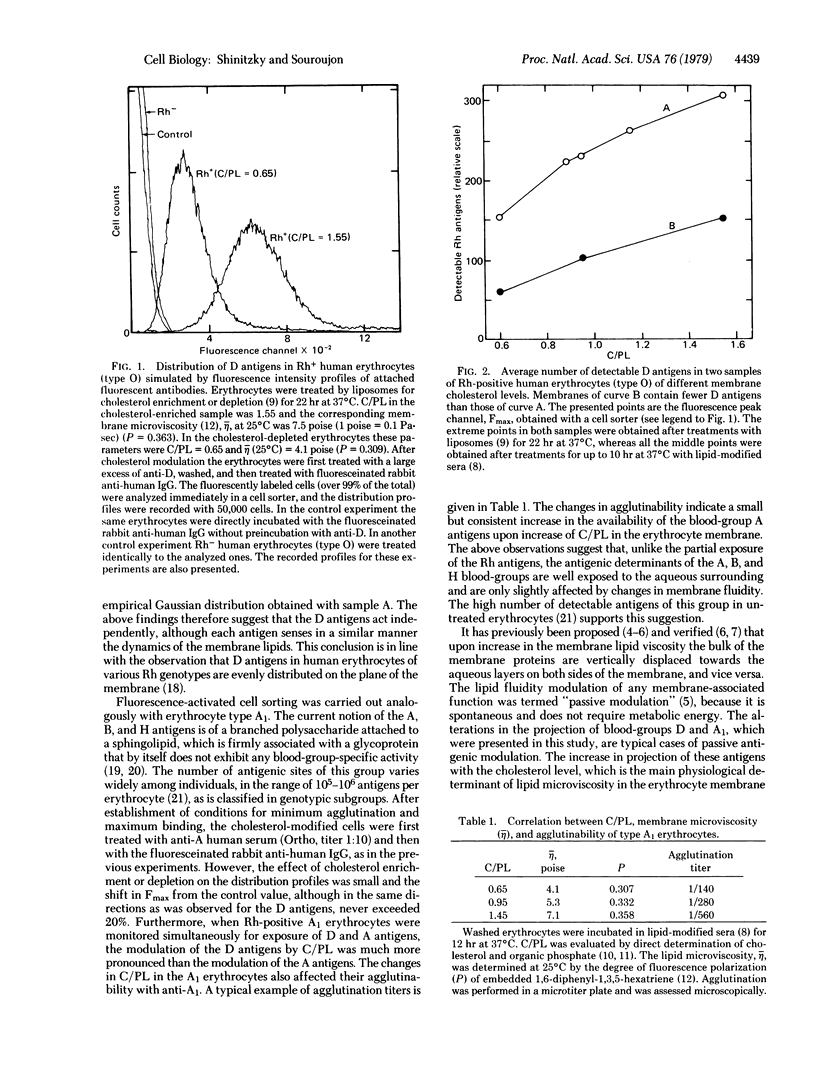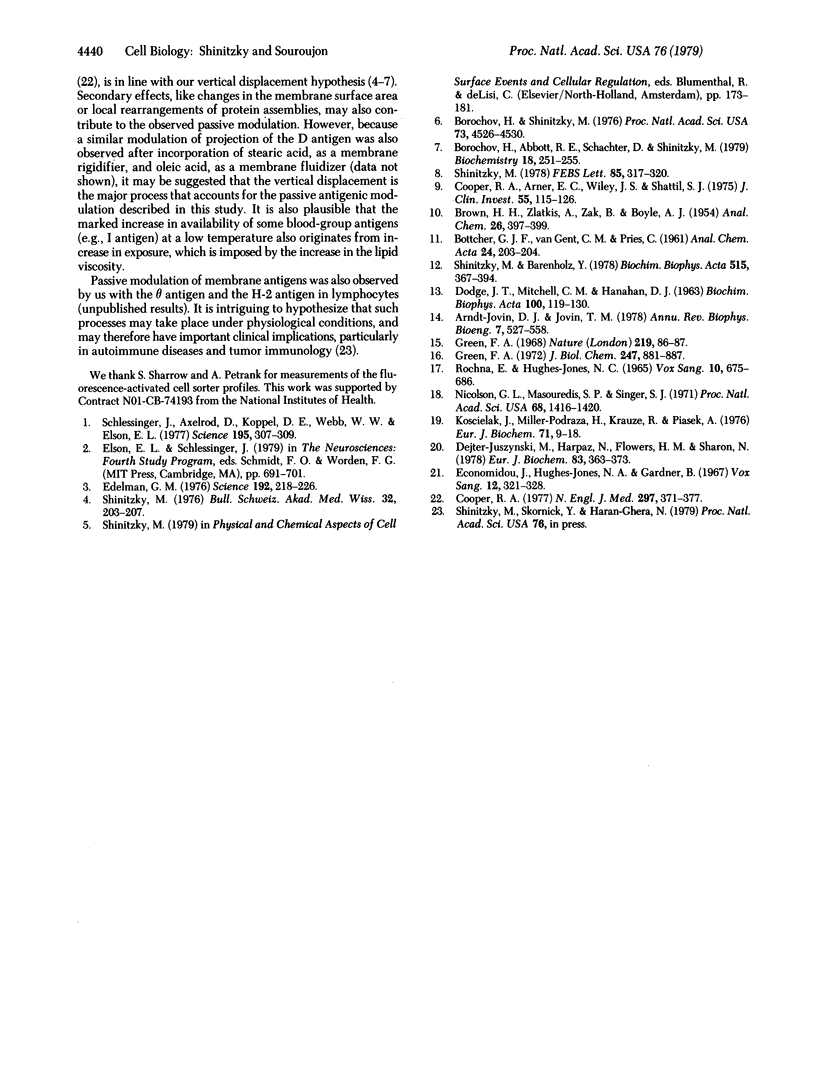Abstract
Rh-positive erythrocytes were enriched and depleted of membrane cholesterol, and the mediated change in the degree of exposure of the D antigens was determined by fluorescence-activated cell sorting, using indirect fluorescent antibody labeling. The results are compatible with a model in which the expression of the D antigens can be modulated significantly by the lipid microviscosity (eta). At a high cholesterol-to-phospholipid ratio (C/PL) of 1.55, which corresponds to eta (25 degrees C) = 7.5 poise (1 poise = 0.1 Pa.sec), the relative detectable number of D antigens was about double than that at C/PL = 0.65, eta (25 degrees C) = 4.1 poise. In analogous experiments similar fluidity changes resulted in only about 20% modulation of expression of the A1 antigen, suggesting that in the native state this antigen is already well exposed on the erythrocyte surface. This type of antigenic modulation may also operate in vivo, and may thus bear some fundamental implications on tumor immunology and autoimmune diseases.
Full text
PDF


Selected References
These references are in PubMed. This may not be the complete list of references from this article.
- Arndt-Jovin D. J., Jovin T. M. Automated cell sorting with flow systems. Annu Rev Biophys Bioeng. 1978;7:527–558. doi: 10.1146/annurev.bb.07.060178.002523. [DOI] [PubMed] [Google Scholar]
- Borochov H., Abbott R. E., Schachter D., Shinitzky M. Modulation of erythrocyte membrane proteins by membrane cholesterol and lipid fluidity. Biochemistry. 1979 Jan 23;18(2):251–255. doi: 10.1021/bi00569a002. [DOI] [PubMed] [Google Scholar]
- Borochov H., Shinitzky M. Vertical displacement of membrane proteins mediated by changes in microviscosity. Proc Natl Acad Sci U S A. 1976 Dec;73(12):4526–4530. doi: 10.1073/pnas.73.12.4526. [DOI] [PMC free article] [PubMed] [Google Scholar]
- Cooper R. A. Abnormalities of cell-membrane fluidity in the pathogenesis of disease. N Engl J Med. 1977 Aug 18;297(7):371–377. doi: 10.1056/NEJM197708182970707. [DOI] [PubMed] [Google Scholar]
- Cooper R. A., Arner E. C., Wiley J. S., Shattil S. J. Modification of red cell membrane structure by cholesterol-rich lipid dispersions. A model for the primary spur cell defect. J Clin Invest. 1975 Jan;55(1):115–126. doi: 10.1172/JCI107901. [DOI] [PMC free article] [PubMed] [Google Scholar]
- DODGE J. T., MITCHELL C., HANAHAN D. J. The preparation and chemical characteristics of hemoglobin-free ghosts of human erythrocytes. Arch Biochem Biophys. 1963 Jan;100:119–130. doi: 10.1016/0003-9861(63)90042-0. [DOI] [PubMed] [Google Scholar]
- Dejter-Juszynski M., Harpaz N., Flowers H. M., Sharon N. Blood-group ABH-specific macroglycolipids of human erythrocytes: isolation in high yield from a crude membrane glycoprotein fraction. Eur J Biochem. 1978 Feb;83(2):363–373. doi: 10.1111/j.1432-1033.1978.tb12102.x. [DOI] [PubMed] [Google Scholar]
- Economidou J., Hughes-Jones N. C., Gardner B. Quantitative measurements concerning A and B antigen sites. Vox Sang. 1967 May;12(5):321–328. doi: 10.1111/j.1423-0410.1967.tb03362.x. [DOI] [PubMed] [Google Scholar]
- Edelman G. M. Surface modulation in cell recognition and cell growth. Science. 1976 Apr 16;192(4236):218–226. doi: 10.1126/science.769162. [DOI] [PubMed] [Google Scholar]
- Green F. A. Erythrocyte membrane lipids and Rh antigen activity. J Biol Chem. 1972 Feb 10;247(3):881–887. [PubMed] [Google Scholar]
- Green F. A. Rh antigenicity: an essential component soluble in butanol. Nature. 1968 Jul 6;219(5149):86–87. doi: 10.1038/219086a0. [DOI] [PubMed] [Google Scholar]
- Kościelak J., Miller-Podraza H., Krauze R., Piasek A. Isolation and characterization of poly(glycosyl)ceramides (megaloglycolipids) with A, H and I blood-group activities. Eur J Biochem. 1976 Dec;71(1):9–18. doi: 10.1111/j.1432-1033.1976.tb11083.x. [DOI] [PubMed] [Google Scholar]
- Nicolson G. L., Masouredis S. P., Singer S. J. Quantitative two-dimensional ultrastructural distribution of Rh o (D) antigenic sites on human erythrocyte membranes. Proc Natl Acad Sci U S A. 1971 Jul;68(7):1416–1420. doi: 10.1073/pnas.68.7.1416. [DOI] [PMC free article] [PubMed] [Google Scholar]
- Rochna E., Hughes-Jones N. C. The use of purified 125-I-labelled anti-gamma globulin in the determination of the number of D antigen sites on red cells of different phenotypes. Vox Sang. 1965 Nov-Dec;10(6):675–686. doi: 10.1111/j.1423-0410.1965.tb05179.x. [DOI] [PubMed] [Google Scholar]
- Schlessinger J., Axelrod D., Koppel D. E., Webb W. W., Elson E. L. Lateral transport of a lipid probe and labeled proteins on a cell membrane. Science. 1977 Jan 21;195(4275):307–309. doi: 10.1126/science.556653. [DOI] [PubMed] [Google Scholar]
- Shinitzky M. An efficient method for modulation of cholesterol level in cell membranes. FEBS Lett. 1978 Jan 15;85(2):317–320. doi: 10.1016/0014-5793(78)80482-7. [DOI] [PubMed] [Google Scholar]
- Shinitzky M., Barenholz Y. Fluidity parameters of lipid regions determined by fluorescence polarization. Biochim Biophys Acta. 1978 Dec 15;515(4):367–394. doi: 10.1016/0304-4157(78)90010-2. [DOI] [PubMed] [Google Scholar]
- Shinitzky M. Membrane changes in malignant cells--modulation of receptors and antigens by lipids. Bull Schweiz Akad Med Wiss. 1976 Dec;32(4-6):203–207. [PubMed] [Google Scholar]


